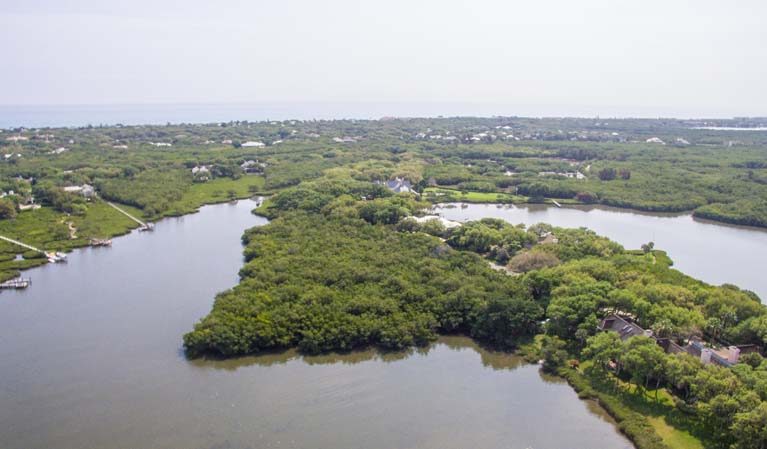
A land dispute case that dragged on for nearly 13 years was decided last week by the United States Supreme Court in favor of John’s Island Club developer Lost Tree Village Corporation.
The case pitted Lost Tree against the Army Corps of Engineers, which in 2004 denied the developer’s request for a permit to develop wetlands on Stingaree Point in Indian River Shores.
On Tuesday, June 27, the Supreme Court declined to review a 2011 federal court ruling that awarded the developer $4.2 million to compensate it for value lost when the Corps blocked its development plans, but the actual award will be much larger, “well north of $10 million,” according to Jerry Stouck, an attorney with the Washington D.C. law firm Greenberg Traurig LLP who represented Lost Tree throughout its protracted legal battle with the government.
“A statute says Lost Tree is entitled to interest on the $4.2 million since 2004, when the permit was denied, and legal fees, which will be hefty,” Stouck says.
Stouck has already been contacted by United States Court of Federal Claims Judge Charles F. Lettow, who will rule on the exact amount due to Lost Tree. “He wants a status conference in the next few weeks, and I am very hopeful we will get this all buttoned up in the next couple of months.
“The case is over. What’s left is just cleanup work.”
“Of course we are delighted with the outcome, but it should never have taken this long,” says Chuck Bayer, president of Lost Tree Development Corporation. “In fact, it should never have happened at all. Had they let us do the project, the environment would have been better off.”
In 2002, Lost Tree applied to the Army Corps of Engineers for a permit to fill wetlands on a 4.99-acre tract adjoining John’s Island, known as Plat 57, in order to develop it for home sites. In 2004, the Corps responded in a letter informing Bayer the project was “contrary to the overall public interest. Therefore, your … permit is hereby denied.”
Wetlands are crucial to the ecological health of the Indian River Lagoon, filtering water and serving as wildlife habitat and fish nurseries, and the Corps decided it would damage the ecosystem to drain the wetlands on Lost Tree’s property.
But Bayer says Lost Tree would have more than made up for the loss of those wetlands by creating a much larger wetland at McCuller’s point, a mile or so north of the Barber Bridge.
“St. Johns River Water Management and the state DEP approved the plan and said the mitigation we proposed would have been overwhelmingly positive for the lagoon environment,” Bayer says.
“We were going to take the 100-acre mosquito impoundment at McCuller’s Point and put in pipes and make a functioning wetland again, which would have been very good for the lagoon. The state said it would be a project of regional significance, but the Corps disagreed.”
Four years later, in 2008, Lost Tree challenged the denial in the United States Court of Federal Claims, arguing that the government had violated its Fifth Amendment rights by taking the value of its property without paying due compensation. (With a fill permit the property was worth millions. Without the permit it was worth only $27,500, according to court calculations.)
The Court of Federal Claims found for the government, agreeing with the argument that Plat 57 was part of a larger “parcel” of John’s Island property, from which Lost Tree had already profited handsomely.
Lost Tree challenged that decision in the United States Court of Appeals, which reversed the lower court, agreeing with Stouck’s argument that Plat 57 was a discrete property that had never been part of any larger master plan. That being the case, the Corps’ refusal to issue a permit wiped out more than 99 percent of the land’s value and made the government liable, under the Fifth Amendment and legal precedent, to compensate Lost Tree.
The case bounced back and forth between the Court of Federal Claims and the Court of Appeals several more times, as the value of the property was adjudicated and the ruling in Lost Tree’s favor was upheld against the government’s repeated appeals.
On June 1, 2015, the Court of Appeals definitively affirmed the judgment, leaving the government one final recourse. After getting the deadline to respond extended twice, the government filed a 265-page “brief” with the Supreme Court on March 17, 2016, arguing that the lower court erred in viewing Plat 57 as a separate, self-contained economic opportunity.
Stouck replied with a 138-page brief on May 3, 2016, and there the matter rested for more than a year, while the Supreme Court considered a related case called Murr v. Wisconsin that likewise dealt with the question of whether a piece of property should be seen as separate or part of a larger development parcel.
“The Supreme Court sat on the government’s writ of certiorari until it decided Murr last Friday,” says Stouck. “Once they made that decision, they realized they were holding onto the government’s petition in our case and proceeded to deny it. They said they were not going to review the federal circuit court decision in our favor.”
Lost Tree never denied the Corps’ right to protect wetlands under the authority of the Clean Water Act. It merely argued that if the government was going to protect the wetlands at its expense, it should be compensated. Thirteen years later, the Supreme Court agreed.



